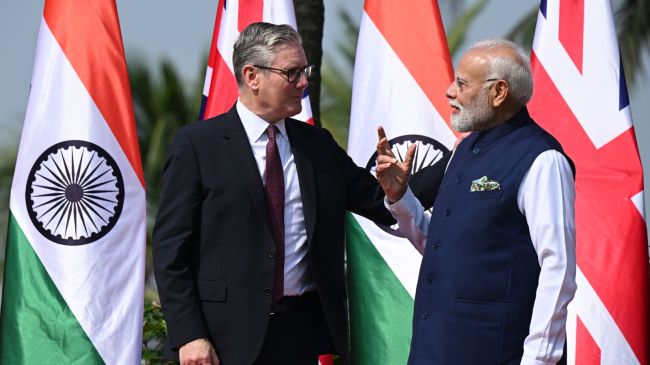Opinion Will British university campuses in India further exclude Bahujans from higher education?
Public universities, already suffering from severe funding shortages and state neglect, may struggle to compete with these foreign institutions
 The UK government has promised to deliver high-quality education in India by offering a UK-wide “degree without leaving home,” while simultaneously boosting the UK economy.
The UK government has promised to deliver high-quality education in India by offering a UK-wide “degree without leaving home,” while simultaneously boosting the UK economy. By Shishu Ranjan
Recently, India and the United Kingdom (UK) signed the historic India-UK Comprehensive Economic and Trade Agreement (CETA) during the visit of UK Prime Minister Keir Starmer to India. This was followed by Indian Prime Minister Narendra Modi’s visit to the United Kingdom on July 23–24.
Under CETA, both countries signed agreements covering multiple sectors. Higher education is one of the key areas in which British universities are set to expand their campuses in India under the Programme of Cultural Co-operation. During the bilateral meeting, the UK PM confirmed the opening of nine British university campuses in India to boost the revenue generated by the UK. Higher education is one of the UK’s greatest exports, contributing £32 billion in 2022. The UK government aims to bring in an additional £50 million from the Indian higher education market.
The University of Southampton was the first to open its campus in Gurugram, Haryana, earlier this year. Following this, Starmer announced the establishment of branch campuses of the University of York, University of Aberdeen, University of Bristol, University of Liverpool, Queen’s University Belfast, Coventry University, Lancaster University and the University of Surrey in different Indian cities.
The Promise and Perils of UK Universities Entering India
The UK government has promised to deliver high-quality education in India by offering a UK-wide “degree without leaving home,” while simultaneously boosting the UK economy. There is no doubt that the quality of UK education meets global standards and carries historical significance since the medieval period and the Industrial Revolution. However, it also carries a colonial legacy.
The intention of the UK government in opening these universities needs to be critically examined. Its primary objective appears to be deriving commercial benefits from the higher education market, especially at a time when the Indian state seems to be withdrawing from higher education and asking higher education institutions (HEIs) to generate their own resources. The motive is clear: to profit by investing in higher education abroad.
At the same time, the Indian government, through the National Education Policy (NEP) 2020, has expressed its intention to make India an international destination for higher education and to “restore its role as a Vishwa Guru.” This raises an important question: How does the Indian government plan to internationalise higher education? By opening the higher education market to powerful Western countries?
The South Asian University (SAU) provides a perfect example where the Indian government has allegedly curtailed the voices of international students from SAARC countries, as well as Indian students and faculty members, even though the university is jointly sponsored. This exposes a serious contradiction in the Indian state’s approach. On one hand, it suppresses international collaboration at SAU, while on the other, it welcomes UK universities to operate freely in India instead of strengthening Indian public universities.
Impact on Indian Universities: Competition or Collaboration?
Recent developments, such as fee hikes, alleged restrictions on academic freedom, and the erosion of campus democracy in central universities like Jawaharlal Nehru University, Jamia Millia Islamia, and the University of Delhi, contradict the stated intent to democratise Indian higher education. Instead, they reveal the state’s drive to commercialise and privatise higher education institutions (HEIs)—a concern long raised by the All India Forum for Right to Education (AIFRTE), a collective of progressive students, teachers, and social justice-based organisations advocating free education from KG to PG.
While the entry of international universities may appear to promote collaboration with Indian universities, in practice, their nexus with the government will likely turn this relationship into competition. Public universities, already suffering from severe funding shortages and state neglect, may struggle to compete with these foreign institutions. This dynamic is already evident in the rise of Indian private universities such as O.P. Jindal University and Ashoka University, which dominate both national and international rankings. Most importantly, these private universities—and, by extension, foreign ones—are prohibitively expensive compared to public universities, making them accessible only to the privileged few.
The Future of Higher Education in India: Integration or Division?
This question becomes even more pressing in an era when higher education operates within a market-oriented framework and is listed under the General Agreement on Trade in Services (GATS) of the World Trade Organisation (WTO). AIFRTE and its allied organisations previously opposed the inclusion of education under GATS during the second term of the UPA government. They rightly argued that the marketisation and commercialisation of higher education would make it unaffordable for most students and exclude marginalised communities such as Dalits, Bahujans, and Adivasis. Moreover, these institutions may offer only superficial, merit-based scholarships for publicity rather than genuine inclusion.
This raises a critical question: For whom are these institutions being opened? Who will truly benefit? What will be the implications of these foreign universities for publicly funded HEIs?
What will happen to the Gross Enrolment Ratio (GER) among Dalit, Bahujan, and Adivasi students, whose participation in higher education already falls below the national average? These issues demand serious discussion among progressive forces, rather than celebration among a privileged few.
The writer is a Chevening Scholar (2024–25). He is associated with the All India Forum for Right to Education (AIFRTE) as a Praesidium Secretariat member and Office Secretary




